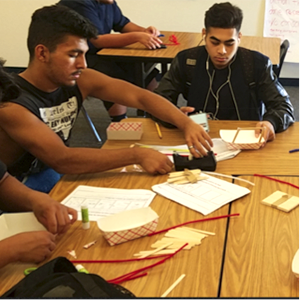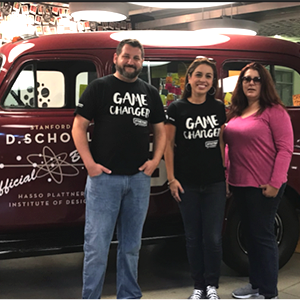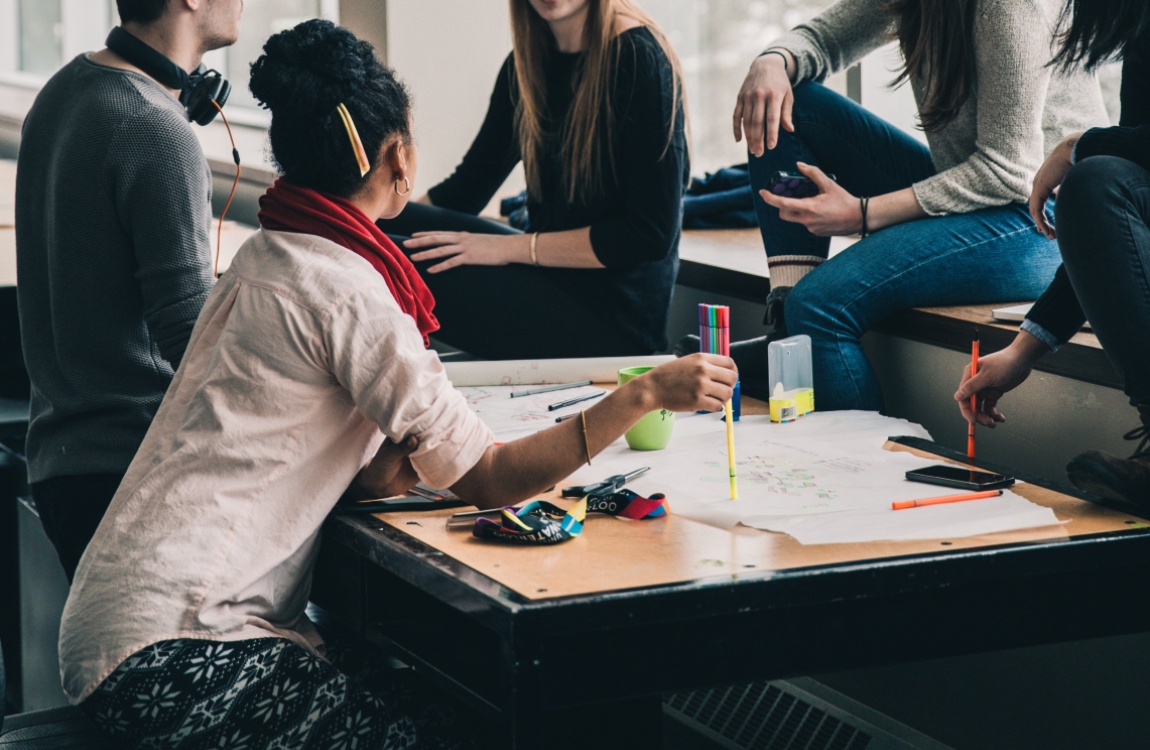As a continuation high school principal searching for new ways to enhance the educational experiences for at-promise youth in Los Angeles County, I am a strong believer that Project Based Learning is the right framework to design learning experiences for students who don’t connect to how high schools usually design learning.
Professional Development and Planning
Fortunately for the students at Nueva Vista Continuation High School in Bassett Unified, we connected with Stanford University’s K12 lab network and attended a workshop to explore how design thinking can be used to create engaging experiences for students. In a beautiful burst of creativity and critical thinking, two teachers and I experienced BIE’s Essential Project Design Elements through two design thinking challenges, “Redesign My Partner’s Morning Routine” and “Design a New City Experience.”
While up at Stanford’s d.school, my team (Jessica and Cynthia) and I re-learned the deep importance of building empathy with others before designing solutions to challenging problems or questions. We learned the steps of design thinking: empathize, define, ideate, prototype, and test. More importantly, the professional development experience taught the power of the d.school’s bias towards action. Each morning we walked up the steps and read a banner hanging in the d.school that declared, “The Only Way to Do It Is To Do It.”
After the workshop, we decided to lead our students and other teachers on a four-day introduction to design thinking with two design thinking challenges similar to what we had done. We learned from the d.school that the tactile experience was important to the ideate and prototype stages of design thinking, so I spent about $120 on Amazon for hands-on materials. We then involved Julia, a passionate advocate for design thinking we met up at the d.school, to give us feedback on our implementation plan. She agreed to do a videotaped entry event to the Classroom Redesign challenge. Involving an outside expert in the design phase was critical to planning and executing the project.
With Students Day 1
 The team had a plan for two projects/challenges with resources ready. We had our students tired and bleary-eyed a Monday morning. Then the superintendent shows up with the entire cabinet to see what’s going on with our Day 1 challenge: Redesign My Partner’s Morning Routine. They got a chance to see the students’ initial reaction to an energizer called, “the Ta-Dah Experience” which is designed to get students comfortable with making mistakes and celebrating each other when they make them. After the morning energizer, the students were teamed up and learned the steps of the design thinking process through hearing about the development of my partner’s morning routine project challenge. Initial reaction from students who never explicitly had to do empathy before? No way! I’m not gonna do this! Can’t we just do normal work and do what we normally do and go home? Nope. The teachers forced the students to persist and at the end of Day 1 they were in love with design thinking.
The team had a plan for two projects/challenges with resources ready. We had our students tired and bleary-eyed a Monday morning. Then the superintendent shows up with the entire cabinet to see what’s going on with our Day 1 challenge: Redesign My Partner’s Morning Routine. They got a chance to see the students’ initial reaction to an energizer called, “the Ta-Dah Experience” which is designed to get students comfortable with making mistakes and celebrating each other when they make them. After the morning energizer, the students were teamed up and learned the steps of the design thinking process through hearing about the development of my partner’s morning routine project challenge. Initial reaction from students who never explicitly had to do empathy before? No way! I’m not gonna do this! Can’t we just do normal work and do what we normally do and go home? Nope. The teachers forced the students to persist and at the end of Day 1 they were in love with design thinking.
With Students Days 2-3
In order to ensure students were working hard on the next design thinking project challenge, Redesign the Classroom Experience, I invited the superintendent, cabinet and the Board of Education to view and give feedback to the students’ prototypes that were going to be developed over the next three days. Hint: this has to be done weeks in advance to make it work. With an authentic public audience lined up to view their work, students were deeply engaged in the 4 C’s. The intentionality of the design thinking curricular materials definitely made things easier for teachers to manage the messy middle of a project: team dynamics, materials and flying play-doh while focusing on thinking and deepening understanding.
The students worked in teams, taking a critical view of conditions at Nueva Vista. They did a school walk and examined the learning environment. They talked to each other about what exists and what they really needed in a learning environment to have success. The students engaged in critique and revision with their problem statements and then built prototypes of improved learning environments.
Day 4: The Payoff
 The payoff came on the last day of the design thinking challenge, when the invited guests had the opportunity to view student prototypes and presentations. I had never seen such a radical transformation in at-promise youth so quickly. Imagine kids on the ropes talking deeply about their thinking and process and sharing their needs with the superintendent and board president. No notecards, no trifold boards, just the prototypes and their enthusiasm with the adults who have the power to make the changes to the school experience.
The payoff came on the last day of the design thinking challenge, when the invited guests had the opportunity to view student prototypes and presentations. I had never seen such a radical transformation in at-promise youth so quickly. Imagine kids on the ropes talking deeply about their thinking and process and sharing their needs with the superintendent and board president. No notecards, no trifold boards, just the prototypes and their enthusiasm with the adults who have the power to make the changes to the school experience.
In the end, we had a debrief where every single student had to reflect on the experiences. Many said the design thinking process mattered. They relished the chance to build empathy and design meaningful solutions to authentic challenges. Two weeks later at a board meeting all the board members could not stop singing the praises of the students’ thinking and creativity.
Overall, student voice and equity is at the heart of Project Based Learning. PBL and design thinking work for all students. The bias towards action and authentically engaging at promise students in meaningful work is vital. The d.school materials linked below can absolutely assist in successful implementation, since the materials scaffold the thinking process so well. Importantly, we learned that PBL can be done well in 15-16 hours of focused classroom work. It takes careful thinking about logistics, but with the resources listed below, the curriculum isn’t the barrier.
I would love to connect with anyone wanting to hear more from Jessica, Cynthia, or me about the experience of PBL for at-promise youth! I can be reached here.
For more information, check these resources:
K12 lab wiki


